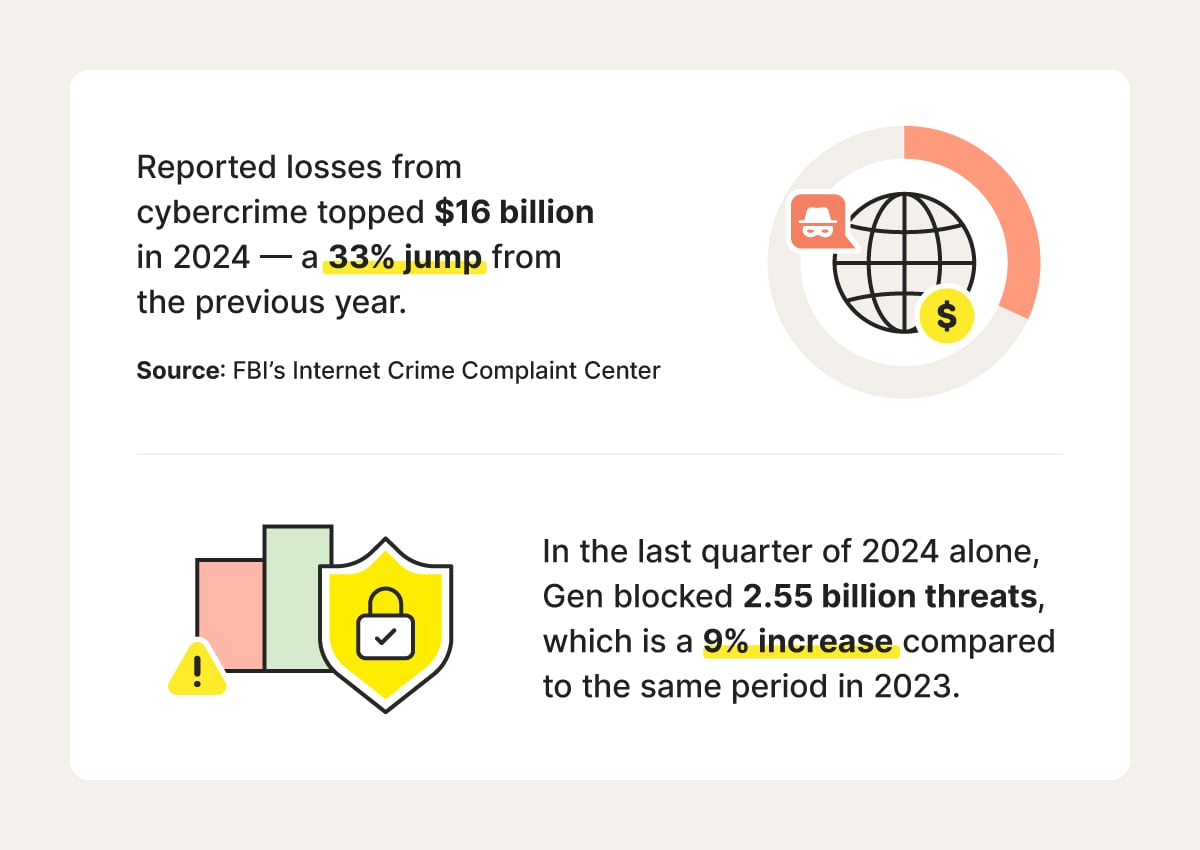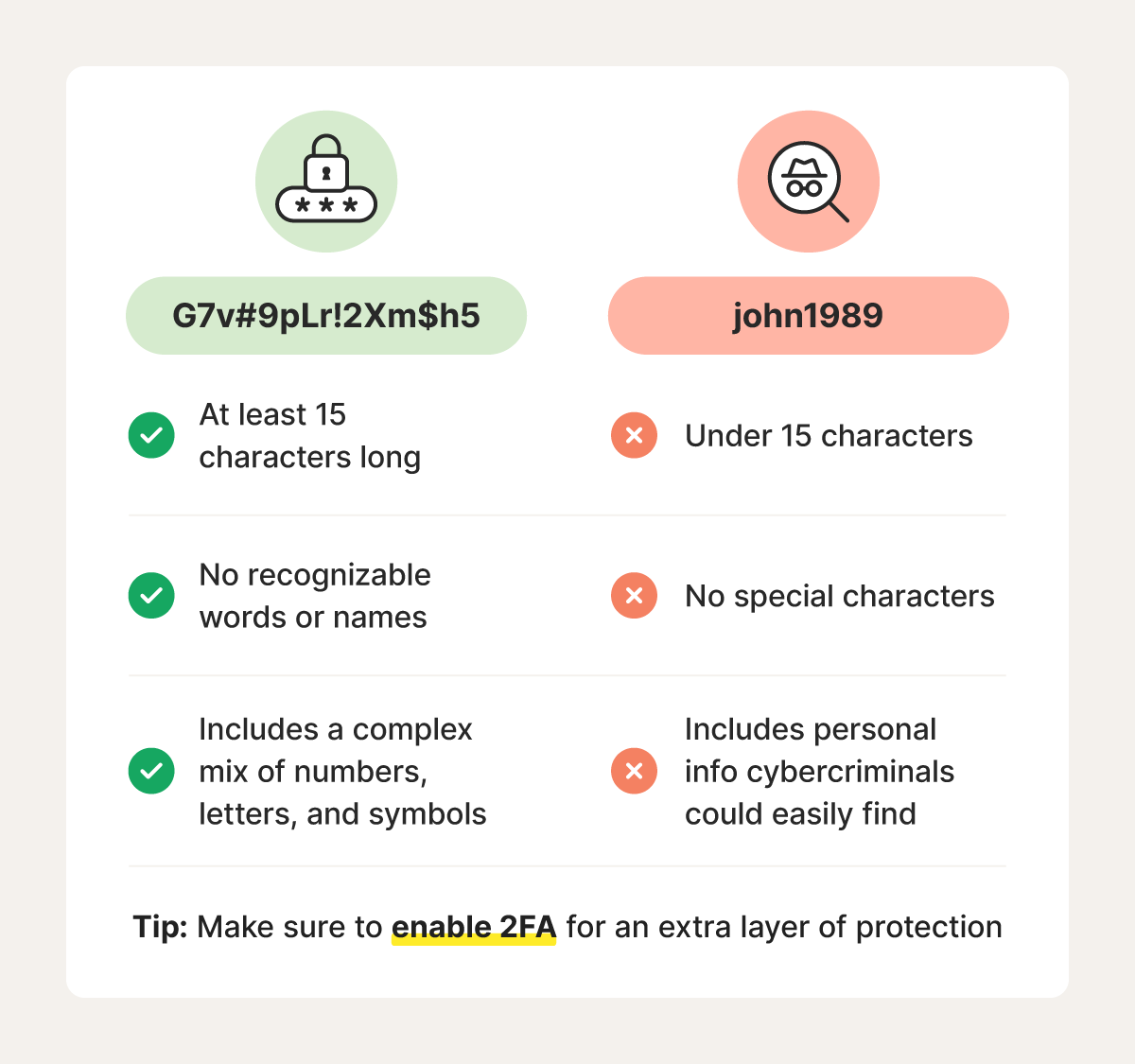How to prevent cybercrime: 11 ways to protect against threats
Cybercrime is on the rise, largely fueled by increasingly sophisticated scams, and resulting in billions in losses each year. That’s why it’s more important than ever to stay one step ahead of fraudsters, hackers, and other cybercrooks with the help of comprehensive protection built to help detect and block threats before they can harm you.

Cybercrime is a diverse threat encompassing a wide range of illegal activities involving networked devices, and it’s only becoming more prevalent. In the last three months of 2024 alone, Gen blocked 2.55 billion threats, marking a 9% increase over the same period in 2023.
The impact on victims can be severe. According to the FBI’s Internet Crime Complaint Center, reported losses from cybercrime topped $16 billion in 2024, a 33% jump year-over-year.


While it’s impossible to completely prevent cybercrime, there are steps you can take to help minimize the risk by protecting your devices, data, identity, and finances. Read on to learn about common types of cybercrime and how to stay safer online.
What is cybercrime?
Cybercrime is any illegal activity that takes place online or using internet-connected devices to commit offenses such as hacking, malware, and identity theft. Cybercriminals aim to exploit cybersecurity vulnerabilities in computer systems or manipulate people to steal money or sensitive data.
While most cybercriminals are driven by financial gain, some are motivated by politics, ideology, or the desire for recognition within hacker communities.
Types of cybercrime
Cybercrime covers a wide range of illegal activities involving the internet, with common types including scams, malware, hacking, data breaches, identity theft, and online harassment. Below is a more detailed breakdown of these specific forms of cybercrime.
Scams and fraud
Scams and fraud involve deceptive tactics that cybercriminals use to steal money or sensitive data. According to Gen’s Q4 Threat Report, internet scams accounted for a staggering 86% of online threats.
From phishing emails to social media scams, fraudsters constantly adapt their tricks to target unsuspecting victims. Many use social engineering to gain trust and manipulate people into clicking harmful links, sending money, or handing over personal information.
Malware
Malware — a portmanteau of “malicious software” — is designed to infiltrate devices, steal data, or gain unauthorized access to accounts that store sensitive information. There are many types of malware, including computer viruses, trojans, adware, worms, and ransomware.
Ransomware attacks in particular are a major cause for concern, having surged for the third consecutive quarter, with a 50% increase in the last three months of 2024. In these attacks, cybercriminals use malware to encrypt a victim’s files and demand payment to restore access. Both individuals and large organizations can be targeted, often facing serious disruption with no guarantee of restoration, even if the ransom is paid.
Hacking
Hacking involves gaining unauthorized access to devices or networks, often by exploiting software or hardware vulnerabilities. While some hackers do so for ethical purposes, such as identifying security vulnerabilities, others act maliciously, using hacking as a cybercrime method to steal data, disrupt systems, or achieve financial gain.
Data breaches
A data breach occurs when unauthorized individuals access confidential information held by a business or organization, often with the intent to sell it on the dark web. Cybercriminals may use tactics like hacking, social engineering attacks, or deploying malware to steal this data. If your information is compromised in a breach, it can leave you exposed to identity theft, financial fraud, and other cybercrimes.
Identity theft
Identity theft, a form of fraud, happens when someone steals your personal or financial information to access your bank account, open new lines of credit, or commit crimes in your name. Criminals often obtain this information on the dark web following other cybercrimes like data breaches, phishing scams, or malware attacks.
Online harassment
Online harassment is the use of digital platforms to intimidate, threaten, or cause emotional harm to someone. It often takes place through emails, text messages, or social media, and can include behaviors like cyberbullying, revenge porn, cyberstalking, and other forms of persistent online abuse.
How to prevent cybercrime from harming your finances and identity
Cybercriminals don’t just target big businesses — everyday internet users are at risk, too. Protecting your identity and finances starts with a few smart, proactive steps. Here are 11 effective ways to help you stay one step ahead.
1. Use strong passwords and enable 2FA
Create strong, unique passwords for each of your online accounts, and avoid reusing them across different sites. A secure password should be at least 15 characters long and include a mix of letters, numbers, and symbols. Enabling two-factor authentication (2FA) adds an extra layer of protection by requiring a second form of verification in addition to your password.
To keep track of your credentials, consider using a trusted password manager.


2. Keep your software updated
Running the latest version of your software ensures you have the most recent security updates and patches. Cybercriminals often exploit known vulnerabilities in outdated software to gain access to your system. Keeping your operating system, apps, and antivirus tools up to date makes it much harder for them to succeed.
3. Manage your social media settings
Review and adjust your social media privacy settings to limit the amount of personal information that is publicly visible. Cybercriminals can gather key details, like your upcoming travel plans or your pet’s name, and use them in social engineering attacks or to answer common security questions.
To reduce your risk, set your profiles to private, avoid oversharing, and delete any accounts you no longer use to minimize your digital footprint.
4. Strengthen your home network
A secure home network is key to protecting your devices and loved ones from cyber threats. Follow these steps to make it harder for cybercriminals to gain access:
- Set a strong, unique password for your home Wi-Fi router. Avoid default network security keys or passwords that are easily guessed.
- Enable the strongest wireless security protocol available — typically WPA3 — to secure your wireless connection.
- Keep your router’s firmware up to date to patch known security vulnerabilities.
- Encrypt your internet traffic with a VPN to secure the data you send and receive, even outside your Wi-Fi network.
Norton VPN uses military-grade encryption to secure your internet connection, making it virtually impossible for hackers or third parties to intercept your data. Whether you’re on public Wi-Fi or your home network, Norton VPN helps you keep your online activity private and your personal information protected.
5. Keep up to date on major security breaches
Staying informed about security breaches helps you to act quickly if your information is exposed. If a company you do business with experiences a data breach, find out what information was compromised. Change your passwords immediately, enable two-factor authentication, and monitor your credit and accounts for signs of identity theft.
6. Monitor your bank statements
Regularly review your bank statements and report any unfamiliar transactions to your bank immediately. Catching fraud early allows you to act quickly and reduce the risk of financial loss.
7. Protect your personal information online
Protecting your personal information online is key to reducing your exposure to cybercrime. Oversharing on social media or exposing sensitive data can give cybercriminals the clues they need to launch spear phishing attacks, guess your security questions, or break into financial and social media accounts.
To stay safe, limit what you share publicly and take steps to remove personal information from the internet, such as old addresses, phone numbers, or other data that criminals could use to impersonate you.
8. Don’t click on suspicious links
To protect against phishing, avoid clicking on suspicious links, especially those from unknown senders or disguised with shortened links. You should be particularly wary of messages with generic greetings or urgent language, as these are common tactics for tricking people into giving up personal information.
9. Take measures to help protect yourself against identity theft
Proactively reduce your risk of identity theft by protecting your Social Security number (SSN) and regularly monitoring your credit to help you catch suspicious activity early if it does occur. To help manage this process for you, consider using an identity theft protection service that monitors your credit and alerts you if something seems off.
10. Use a full-service internet security suite
No matter how cautious you are online, you can’t eliminate your exposure to cybercrime entirely. Even with smart habits, vulnerabilities remain, which is why having strong cybersecurity software is so important.
Norton 360 Deluxe provides all-in-one protection with cutting-edge antivirus and AI-powered scam detection to help defend against hackers, fraudsters, malware, and other evolving threats.
11. Know what to do if you become a victim
If you’re targeted by cybercrime, swift action is crucial to limiting damage to your finances, identity, and personal data. Here are the key steps you should take immediately:
- Notify your bank or credit card issuer: If your financial information was compromised, notify your bank immediately. They can monitor for suspicious activity, freeze your accounts if needed, and guide you through recovery steps.
- Update your passwords: Change the passwords for your online accounts, especially your email, mobile banking, and social media, to help prevent further unauthorized access.
- Place a fraud alert: Contact one of the major credit bureaus and request a fraud alert to make it harder for identity thieves to open new credit accounts in your name.
- Report the cybercrime: File a report with the relevant authorities. Even seemingly minor incidents should be reported, as your information could help prevent future attacks or assist ongoing investigations.
How to report cybercrime
If you believe that you’ve become a victim of a cybercrime, it’s important to report it to the appropriate authorities, such as the FBI’s Internet Crime Complaint Center (IC3), the Federal Trade Commission (FTC), or your local law enforcement. Here’s how:
- File a complaint with the IC3: Visit ic3.gov and complete the online form.
- Report fraud to the FTC: Go to reportfraud.ftc.gov and fill out their online form.
- Contact your local law enforcement: Use the non-emergency phone number or visit their website to check if an online reporting option is available.
Don’t let cybercrime catch you off guard
Cybercrime can strike almost anyone at any time, so don’t wait to react — get ahead of it. Norton 360 Deluxe makes protecting yourself simple, with powerful, all-in-one security that includes AI-driven scam detection, a password manager, antivirus, VPN, and more. Boost your defenses today and start leading a more secure, confident digital life.
FAQs
How often does cybercrime happen?
Cybercrime is a constant and growing threat. According to a recent Gen Threat Report, 321 illegal cyberattacks occurred every second during the last three months of 2024.
What is the strongest protection against cyberthreats?
The most effective protection against cyberthreats comes from a multi-layered security approach. This includes using strong, unique passwords; enabling multi-factor authentication; regularly updating your software and devices; being cautious with links and downloads; and installing reputable security software like Norton 360 Deluxe, which combines features like real-time threat detection, firewalls, and a secure VPN.
What is the biggest cybercrime?
Ransomware attacks are widely regarded as one of the most serious and large-scale forms of cybercrime. In these attacks, hackers encrypt a victim’s data and demand payment to restore access — often crippling businesses, infrastructure, or entire services. High-profile incidents like the Colonial Pipeline attack have caused widespread disruption, highlighting the growing scale and impact of ransomware.
Editorial note: Our articles provide educational information for you. Our offerings may not cover or protect against every type of crime, fraud, or threat we write about. Our goal is to increase awareness about Cyber Safety. Please review complete Terms during enrollment or setup. Remember that no one can prevent all identity theft or cybercrime, and that LifeLock does not monitor all transactions at all businesses. The Norton and LifeLock brands are part of Gen Digital Inc.









Want more?
Follow us for all the latest news, tips, and updates.